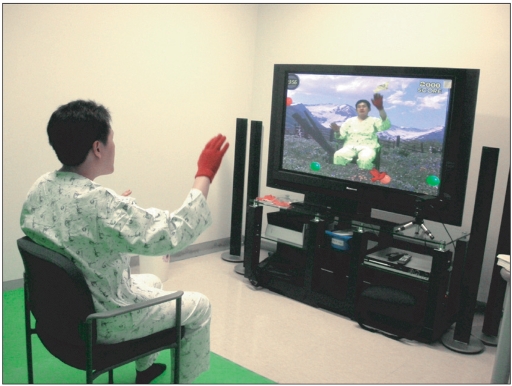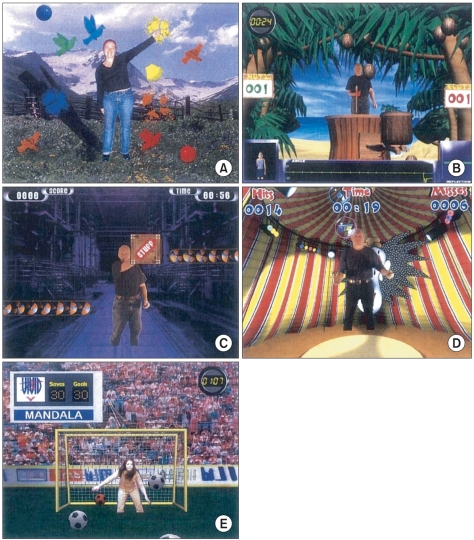Ann Rehabil Med.
2011 Aug;35(4):450-459. 10.5535/arm.2011.35.4.450.
Effect of Virtual Reality on Cognition in Stroke Patients
- Affiliations
-
- 1Department of Rehabilitation Medicine, Asan Medical Center, University of Ulsan College of Medicine, Seoul 138-736, Korea. mhchun@amc.seoul.kr
- 2Department of Rehabilitation Medicine, Jeju National University College of Medicine, Jeju 690-767, Korea.
- 3Department of Rehabilitation Medicine, Philip Hospital, Seoul 138-170, Korea.
- KMID: 1971709
- DOI: http://doi.org/10.5535/arm.2011.35.4.450
Abstract
OBJECTIVE
To investigate the effect of virtual reality on the recovery of cognitive impairment in stroke patients. METHOD: Twenty-eight patients (11 males and 17 females, mean age 64.2) with cognitive impairment following stroke were recruited for this study. All patients were randomly assigned to one of two groups, the virtual reality (VR) group (n=15) or the control group (n=13). The VR group received both virtual reality training and computer-based cognitive rehabilitation, whereas the control group received only computer-based cognitive rehabilitation. To measure, activity of daily living cognitive and motor functions, the following assessment tools were used: computerized neuropsychological test and the Tower of London (TOL) test for cognitive function assessment, Korean-Modified Barthel index (K-MBI) for functional status evaluation, and the motricity index (MI) for motor function assessment. All recruited patients underwent these evaluations before rehabilitation and four weeks after rehabilitation.
RESULTS
The VR group showed significant improvement in the K-MMSE, visual and auditory continuous performance tests (CPT), forward digit span test (DST), forward and backward visual span tests (VST), visual and verbal learning tests, TOL, K-MBI, and MI scores, while the control group showed significant improvement in the K-MMSE, forward DST, visual and verbal learning tests, trail-making test-type A, TOL, K-MBI, and MI scores after rehabilitation. The changes in the visual CPT and backward VST in the VR group after rehabilitation were significantly higher than those in the control group.
CONCLUSION
Our findings suggest that virtual reality training combined with computer-based cognitive rehabilitation may be of additional benefit for treating cognitive impairment in stroke patients.
Keyword
Figure
Cited by 3 articles
-
Effectiveness of Commercial Gaming-Based Virtual Reality Movement Therapy on Functional Recovery of Upper Extremity in Subacute Stroke Patients
Jun Hwan Choi, Eun Young Han, Bo Ryun Kim, Sun Mi Kim, Sang Hee Im, So Young Lee, Chul Woong Hyun
Ann Rehabil Med. 2014;38(4):485-493. doi: 10.5535/arm.2014.38.4.485.Effect of Virtual Reality on Cognitive Dysfunction in Patients With Brain Tumor
Seoyon Yang, Min Ho Chun, Yu Ri Son
Ann Rehabil Med. 2014;38(6):726-733. doi: 10.5535/arm.2014.38.6.726.Novel Virtual Reality Application in Field of Neurorehabilitation
Jeonghun Ku, Youn Joo Kang
Brain Neurorehabil. 2018;11(1):. doi: 10.12786/bn.2018.11.e5.
Reference
-
1. Leys D, Henon H, Pasquier F. White matter changes and poststroke dementia. Dement Geriatr Cogn Disord. 1998; 9(Suppl 1):25–29. PMID: 9716241.
Article2. Pohjasvaara T, Erkinjuntti T, Vataja R, Kaste M. Dementia three months after stroke. Baseline frequency and effect of different definitions of dementia in the Helsinki Stroke Aging Memory Study (SAM) cohort. Stroke. 1997; 28:785–792. PMID: 9099197.3. Cicerone KD, Dahlberg C, Kalmar K, Langenbahn DM, Malec JF, Berquist TF, Felicetti T, Giacino JT, Harley JP, Harrington DE, et al. Evidence-based cognitive rehabilitation: recommendations for clinical practice. Arch Phys Med Rehabil. 2000; 81:1596–1615. PMID: 11128897.
Article4. Gontkovsky ST, McDonald NB, Clark PG, RuWe WD. Current directions in computer-assisted cognitive rehabilitation. Neurorehabilitation. 2002; 17:195–199. PMID: 12237499.
Article5. Diamond PT, Felsenthal G, Maccinocchi SN, Butler DH, Lally-Cassady D. Effect of cognitive impairment on rehabilitation outcome. Am J Phys Med Rehabil. 1996; 75:40–43. PMID: 8645438.6. Glisky EL, Schacter DL, Tulving E. Learning and retention of compter-related vocabulary in memory-impaired patients: method of vanishing cues. J Clin Exp Neuropsychol. 1986; 8:292–312. PMID: 3755140.7. Chen SH, Thomas JD, Glueckauf RL, Bracy OL. The effectiveness of computer-assisted cognitive rehabilitation for persons with traumatic brain injury. Brain injury. 1997; 11:197–209. PMID: 9058001.
Article8. Niemann H, Ruff RM, Base CA. Computer-assisted attention retraining in head-injured individuals: a controlled efficacy study of an outpatient program. J Consult Clin Psychol. 1990; 58:811–817. PMID: 2292631.
Article9. Kim YH, Ko MH, Seo JH, Park SH, Kim KS, Jang EH, Park SW, Park JH, Cho YJ. Effect of computer-assisted cognitive rehabilitation program for attention training in brain injury. J Korean Acad Rehabil Med. 2003; 27:830–839.10. Parsons TD, Rizzo AA. Initial validation of a virtual environment for assessment of memory functioning: virtual reality cognitive performance assessment test. Cyberpsychol Behav. 2008; 11:17–25. PMID: 18275308.
Article11. Parsons TD, Rizzo AA. Neurpsychological assessment using the virtual reality cognitive performance assessment test. Proceedings of the 7th ICDVRAT with Art-Abilitation. 2008. 2008 Aug 31-Sep 2; Maia, Portugal. UK: University of Reading.12. Parsons TD, Larson P, Kratz K, Thiebaux M, Bluestein B, Buckwalter JG, Rizzo AA. Sex differences in mental rotation and spatial rotation in a virtual environment. Neuropsychologia. 2004; 42:555–562. PMID: 14728927.
Article13. Matheis RJ, Schultheis MT, Tiersky LA, Deluca J, Millis SR, Rizzo A. Is learning and memory different in a virtual environment? Clin Neuropsychol. 2007; 21:146–161. PMID: 17366282.
Article14. Hofmann M, Rosler A, Schwarz W, Muller-Spahn F, Krauchi K, Hock C, Seifritz E. Interactive computer-training as a therapeutic tool in Alzheimer's disease. Compr Psychiatry. 2003; 44:213–219. PMID: 12764709.
Article15. Cushman LA, Stein K, Duffy CJ. Detecting navigational deficits in cognitive aging and Alzheimer disease using virtual reality. Neurology. 2008; 71:888–895. PMID: 18794491.
Article16. Davidsdottir S, Wagenaar R, Young D, Cronin-Golomb A. Impact of optic flow perception and egocentric coordinates on veering in Parkinson's disease. Brain. 2008; 131:2882–2893. PMID: 18957454.
Article17. Werner P, Rabinowitz S, Klinger E, Korczyn AD, Josman N. Use of the virtual action planning super market for the diagnosis of mild cognitive impairment: a preliminary study. Dement Geriatr Cogn Disord. 2009; 27:301–309. PMID: 19252401.18. Optale G, Urgesi C, Busato V, Marin S, Piron L, Priftis K, Gamberini L, Capodieci S, Bordin A. Controlling memory impairment in elderly adults using virtual reality memory training: a randomized controlled pilot study. Neurorehabil Neural Repair. 2010; 24:348–357. PMID: 19934445.
Article19. Kim DY, Joo SY, Park CI, Park TH, Par KD, Jung KJ, Lee JH. Assessment of post-stroke cognitive dysfunction using 3-dimensional virtual reality program. J Korean Acad Rehabil Med. 2009; 33:12–20.20. Kim DY, Lee JH, Park CI, Kim YW, Chang WH, Kim IY, Kim SI, Chon JS, Chang HJ. Assessment of post-stroke unilateral neglect using 3-dimensional virtual reality program. J Korean Acad Rehabil Med. 2005; 29:1–8.21. Kang YJ, Ku JG, Han KW, Kim SI, Yu TW, Lee JH, Park CI. Development and clinical trial of virtual reality-based cognitive assessment in people with stroke: preliminary study. Cyberpsychol Behav. 2008; 11:329–339. PMID: 18537503.
Article22. Kim JH, Kim KG, Kim DY, Chang WH, Park CI, Ohn SH, Han KW, Ku JH, Nam SW, Kim IY, et al. Virtual environment training system for rehabilitation of stroke patients with unilateral neglect: crossing the virtual street. Cyberpsychol Behav. 2007; 10:7–15. PMID: 17305443.
Article23. Rose FD, Brooks BM, Attree EA, Parslow DM, Leadbetter AG, McNaill JE, Jayawardena S, Greenwood R, Potter J. A preliminary investigation into the use of virtual environments in memory retraining after vascular brain injury: indications for future strategy? Disabil Rehabil. 1999; 21:548–554. PMID: 10608651.24. Kim YH, Shin SH, Park SH, Ko MH. Cognitive assessment for patient with brain injury by computerized neuropsychological test. J Korean Acad Rehabil Med. 2001; 25:209–216.25. Phillips LH, Wynn V, Gilhooly KJ, Della Sala S, Logie RH. The role of memory in the tower of London task. Memory. 1999; 7:209–231. PMID: 10645380.26. Ben-Yishay Y, Piasetsky EB, Rattock J. Meier MJ, Benton AL, Diller L, editors. A systematic method for ameliorating disorders in basic attention. Neuropsychological rehabilitation. 1987. 1st ed. New York: Churchill Livingstone;p. 165–181.27. Kim MY, Lee KS, Choi JS, Kim HB, Park CI. Effectiveness of cognitive training based on virtual reality for the elderly. J Korean Acad Rehabil Med. 2005; 29:424–433.28. Wilson PN, Foreman N, Tlauka M. Transfer of spatial information from a virtual to a real environment in physically disabled children. Disabil Rehabil. 1996; 18:633–637. PMID: 9007423.
Article29. Stanton D, Foreman N, Wilson P, Duffy H, Parnell R. Use of virtual environments to acquire spatial under standing of real-world multi-level environments. Proceedings of the 4th International Conference on Disability, Virtual Reality and associated Technologies. 2002. 2002 Sep 18-20; Veszprem, Hungary. UK: University of Reading.30. Fordyce DE, Farrar RP. Enhancement of spatial learning in F344 rats by physical activity and related learning-associated alterations in hippocampal and cortical cholinergic functioning. Behav Brain Res. 1991; 46:123–133. PMID: 1664728.
Article31. Grealy MA, Johnson DA, Rushton SK. Improving cognitive function after brain injury: the use of exercise and virtual reality. Arch Phys Med Rehabil. 1999; 80:661–667. PMID: 10378492.
Article
- Full Text Links
- Actions
-
Cited
- CITED
-
- Close
- Share
- Similar articles
-
- Virtual Reality Technology Trends in Aeromedical Field
- The digital literacy, awareness, and educational needs of virtual reality among nursing students
- Assessment of Post-Stroke Cognitive Dysfunction Using 3-Dimensional Virtual Reality Program
- Virtual Reality Community Gait Training Using a 360° Image Improves Gait Ability in Chronic Stroke Patients
- The Effect of Virtual Reality Training on Unilateral Spatial Neglect in Stroke Patients



